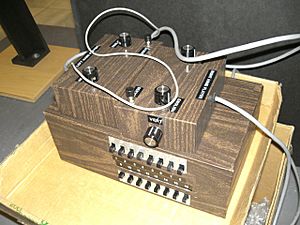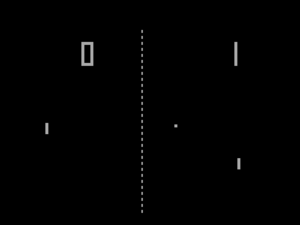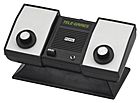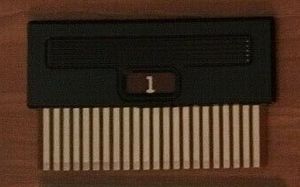First generation of video game consoles facts for kids
The first generation of video games was a really exciting time for gaming! It lasted from 1972 to 1983. During this period, we saw the very first home video game consoles. Some famous ones include the Odyssey series, the Atari Home Pong, and the Coleco Telstar series. This era ended around 1980, but many companies had already left the market because of a dip in sales in 1977 and the start of the second generation of video game consoles.
Most games from this time were built right into the consoles. You couldn't usually swap games like you do with modern consoles. Instead, consoles often came with extra parts or special cards that changed how the game played. The graphics were very simple, just dots, lines, or blocks on a single screen. Early consoles could only show one or two colors. Sound was also very basic, with some consoles having no sound at all!
In 1972, two big things happened that changed home video games forever. In June, Nolan Bushnell and Ted Dabney started Atari. This company became one of the most famous in gaming history. Then, in September, Magnavox released the Magnavox Odyssey. This was the very first home video game console! Even though it wasn't a huge seller, the Odyssey introduced important ideas like games on separate cards and controllers for two players. Atari was inspired by the Odyssey's ping-pong game and soon released its own hit game, Pong, for both arcades and homes. Later, in 1977, Nintendo, a well-known Japanese company, entered the video game world with its Color TV-Game series.
How Early Video Games Started
The First Ideas for Home Gaming
In 1951, a smart engineer named Ralph Baer had an idea for an interactive television. He thought of this while building a TV set. He didn't work on the idea right away, but it came back to him in 1966. At that time, he was a chief engineer at a company called Sanders Associates.
By December 1966, Ralph Baer and a technician made a simple test machine. It let a player move a line across the TV screen. Their boss liked the idea, and the project became official. Baer spent months designing better versions. In February 1967, another technician, Bill Harrison, joined the team to build the new machines.
Baer also worked with engineer Bill Rusch to design the console and think up games. By May, they had their first game. By June, they had many games for their second test machine. These included a game where players controlled dots chasing each other and a shooting game with a plastic rifle. By August 1967, they had a third test machine. Baer felt he needed more help making fun games, so Bill Rusch joined the project full-time. Rusch quickly came up with a way to show three dots on the screen instead of two. He also suggested making a ping-pong game.

Since Sanders was a company that worked for the military, they didn't sell electronics to people. So, the team looked for other companies to make their console. They talked to several TV companies but couldn't find anyone interested at first. By January 1969, they had made their seventh and final test machine, which they called the "Brown Box."
After a lawyer suggested talking to TV makers, RCA showed some interest. Finally, Magnavox was very interested! They started talking in July 1969 and signed a deal in January 1971. Magnavox designed how the console looked on the outside. They also changed some of the inside parts, with help from Baer and Harrison. They removed the color feature and made the controllers simpler. They also changed how you picked games from a dial to special game cards. These cards changed the console's circuits when you plugged them in. Magnavox named the console the Magnavox Odyssey and announced it would launch in September 1972.
Atari and the Rise of Pong
In the late 1960s, Nolan Bushnell saw a game called Spacewar! at Stanford University. Spacewar! was a game made in 1962 by students and staff at the Massachusetts Institute of Technology. Bushnell had worked at an amusement park and thought an arcade version of Spacewar! would be very popular. However, the computers needed to run the game were too expensive for an arcade machine.
By 1970, minicomputers started to become cheaper. Bushnell and his office mate, Ted Dabney, decided to work together to design a test version of the game. By the end of November 1970, they gave up on the project because the affordable computers weren't powerful enough. But Dabney soon thought of a way to control the video signal on the screen without a computer. From this idea, their company, Syzygy Engineering, decided to build special hardware just for the game, without needing a computer at all.
Their first arcade video game, Computer Space, was released by Syzygy Engineering through Nutting Associates in late 1971. After that, they officially formed Atari in 1972 and started designing more games. In early 1972, Bushnell saw a demonstration of the Odyssey console playing its Table Tennis game. He then asked their first employee, Allan Alcorn, to create an arcade table tennis game. The game, Pong, became the first huge success in arcade video games. It led to many other arcade and home versions, including Atari's own Home Pong in 1975.
How the Consoles Worked
The first generation of consoles didn't have a main microprocessor like today's computers. Instead, they used special electronic circuits called discrete logic (TTL) circuits. These circuits were built for each part of the game. As time went on, technology got better. Later consoles used special integrated circuits (chips) that combined many circuits into one. Examples include Atari's Pong chips and General Instruments' AY-3-8500 series.
Graphics were very simple throughout this time. Often, games used physical accessories or overlays on the TV screen to make the game look better. The Odyssey could only show three square dots in black and white. But as the generation continued, consoles started showing color and more complex shapes and text. Early consoles like the Odyssey and TV Tennis Electrotennis made players keep score by hand. Later, many consoles added score counters right on the screen. Sound also slowly got better. The Odyssey had no sound at all. Later consoles had simple buzzers that could make a few beeps and buzzes.
Too Many Consoles and the End of an Era
In 1976, a company called General Instruments made a series of affordable chips. These chips made it much easier and cheaper for companies to build consoles. Because of this, many companies jumped into the home console market in the late 1970s.
A lot of these new consoles were just copies of Atari's Home Pong. Many were made quickly and not very well, which flooded the market. There were so many consoles that people stopped buying them as much. The demand for the new chips was so high that General Instruments couldn't make enough for everyone. This caused problems for some smaller companies. Coleco, however, got their chips early. This helped them make many consoles and have great success with their Telstar range.
The second generation of video game consoles began in 1976 with the release of the Fairchild Channel F. This new technology quickly made the first-generation consoles seem old. Consumers could buy new games for second-generation consoles, instead of needing to buy a whole new system for new content. For example, the Atari VCS launched with a game card that had 27 games! As people switched to the newer systems, some companies were left with too many old consoles and had to sell them at a loss.
This mix of too many consoles and the arrival of new technology caused many companies to leave the market completely. These events became known as the video game crash of 1977. Sales of second-generation consoles were slow for a few years until a very popular game, the home version of Space Invaders, came out for the Atari VCS in 1980.
Famous Home Consoles

There were hundreds of home video game consoles made during the first generation. Here are some of the most important ones.
The Odyssey Series
In 1972, Magnavox released the world's first home video game console, the Magnavox Odyssey. It came with things like cards, paper money, and dice to make the games more fun. It had features that became standard later, like controllers you could detach and special light gun accessories. It also used game cards that you could swap. These cards didn't store game data like modern cartridges. Instead, they changed the console's circuits to let you play one of the twelve games built into the machine. Magnavox also made other companies pay a fee to use its video game ideas.
This was also how Nintendo first got involved in home video games. In 1971, Nintendo worked with Magnavox to make light guns for the Odyssey. This was similar to toys Nintendo already made in Japan.
In 1974, Philips bought Magnavox. They released eight more Odyssey consoles in North America from 1975 to 1977. All of these were "dedicated" consoles, meaning they had games built in. Each new console was a bit better than the last. They added more game types, scores on the screen, and ways for players to make the game harder, like smaller paddles or faster balls. Three Odyssey consoles were also released in Europe from 1976 to 1978.
TV Tennis Electrotennis
On September 12, 1975, a few months before Home Pong came out in North America, Epoch released Japan's first home console, the TV Tennis Electrotennis. It used technology from Magnavox. It had one game, a ball-and-paddle style game like Pong, but it didn't show the score on the screen. The game controls were on the main unit. It connected to a TV using a special antenna, which was unique at the time. It didn't sell very well, with only about 20,000 units sold.
Atari Home Pong
In late 1975, Atari released a home version of their popular arcade game Pong. This was the first time Atari used a microchip in one of its products. It had been in development since 1974. By the end of 1975, Atari became a major company in the home console market thanks to Home Pong. Because of Pong's success, Magnavox sued Atari for using their technology ideas. They settled the lawsuit, and Atari became a company that paid Magnavox to use its patents.
Home video games became very popular with the release of Home Pong. Its success led to hundreds of similar games and consoles. These included the Coleco Telstar, which sold very well with over a dozen different models, and the Binatone TV Master from a British company.
Coleco Telstar Series
Starting in 1976, Coleco released a series of fourteen dedicated consoles. They continued until 1978, when they lost a lot of money. This was due to a dock workers' strike, which stopped them from shipping products for the holidays, and the start of the second generation of consoles. The Telstar series had many different types of ball games. Some models came with extra parts like the Telstar Arcade, which had a unique triangle shape and came with a light gun and a steering wheel. The Telstar series was sold at a lower price than its competitors and sold very well, with over a million units sold.
Color TV-Game Series
In the late 1970s, Nintendo released a series of five consoles for the Japanese market. The first one, the Color TV-Game 6, came out in 1977. It was Nintendo's first console and had six ball-and-paddle games. The last one, the Computer TV-Game, was released in 1980. It was a home version of Nintendo's first arcade game, Computer Othello. The third console in the series, the Color TV-Game Racing 112, was the first project for Shigeru Miyamoto. He later became the creator of some of the most famous video game series in the world!
Comparing First-Generation Home Consoles
| Name | Magnavox Odyssey | Odyssey series (11 consoles) |
TV Tennis Electrotennis |
|---|---|---|---|
| Manufacturer | Magnavox | Magnavox, Philips | Epoch Co. |
| Image |  |
 |
 |
| Launch price | US$100 (equivalent to $700 in 2022) | US$100–230 (equivalent to $544–1251 in 2022) | JP¥19,500 (equivalent to ¥36,600 in 2019) US$66 (equivalent to $359 in 2022) |
| Release date |
|
|
|
| Media | Printed circuit board | Inbuilt chip | Inbuilt chip |
| Accessories (retail) |
Light gun (sold separately) | None | None |
| Sales | 350,000 | Unknown | 20,000 |
| Name | Home Pong | Coleco Telstar series (14 models) |
Color TV-Game series (5 consoles) |
|---|---|---|---|
| Manufacturer | Atari, Sears Tele-Games | Coleco | Nintendo |
| Image |  |
 |
 |
| Launch price | US$98.95 (equivalent to $538 in 2022) JP¥24,800 (equivalent to ¥46,500 in 2019) |
US$50 (equivalent to $257 in 2022) | JP¥9800–48,000 (equivalent to ¥15,559–65,347 in 2019) US$36–179 (equivalent to $174–636 in 2022) |
| Release date |
|
|
|
| Media | Inbuilt chip | Inbuilt chip (most models) Cartridge (Telstar Arcade, 1977) |
Inbuilt chip |
| Accessories (retail) | None | Controller styles | None |
| Sales | 150,000 | 1 million | 3 million |
Handheld Gaming Systems
All the handheld systems from the first generation were "dedicated" consoles. This means they had games built right into them. You couldn't buy new games separately until the Microvision came out in the second generation. These early handhelds eventually became less popular when programmable video games, like the Game Gear, became big in the fourth generation.
One famous example is the Mattel handheld game series, released from 1977 to 1982. The first ones were Mattel Auto Race and Mattel Football. Other games followed, based on sports and even some licensed movies like Battlestar Galactica. Each game had simple controls, a basic light-up screen, and a buzzer for sound. This series was very popular and sometimes hard to find because everyone wanted one!
In the same year, Coleco also started making handheld consoles after their Telstar home console series ended. They released Electronic Quarterback, which added new features to the popular American football games. Along with Mattel Football, it became another very popular sports game of that time.
See also
 In Spanish: Videoconsolas de primera generación para niños
In Spanish: Videoconsolas de primera generación para niños
- 1970s in video games
- Home computer
- History of computing hardware (1960s–present)


